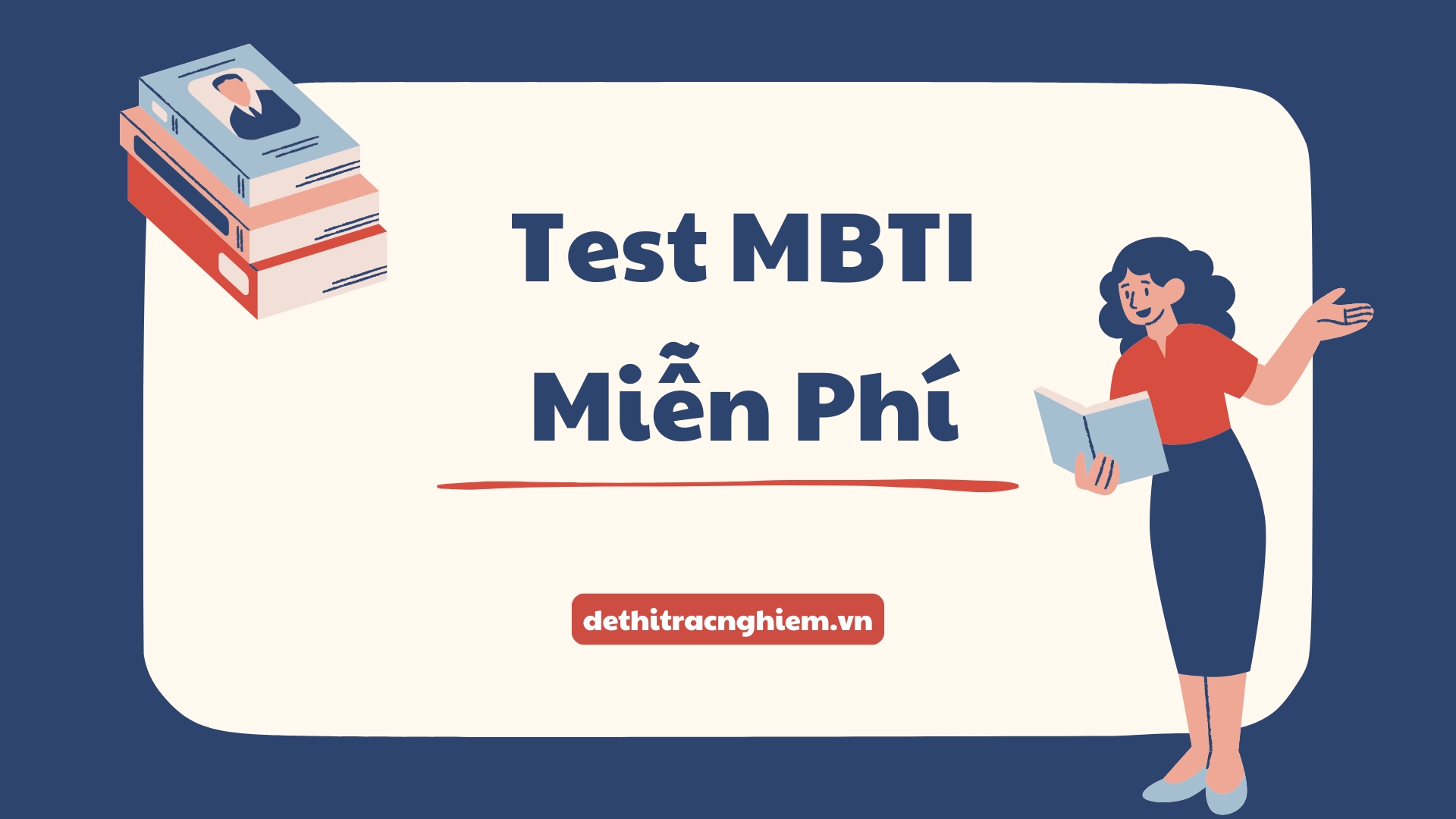Đề thi thử Đại học 2025 môn Tiếng Anh – THPT Nguyễn Công Trứ 2025 là một trong những đề tiêu biểu thuộc Tổng hợp đề thi thử môn Tiếng Anh THPT QG, nằm trong chương trình Đề thi vào Đại học. Đây là đề thi thử được tổ chức bởi Trường THPT Nguyễn Công Trứ, nhằm giúp học sinh lớp 12 ôn luyện toàn diện kiến thức và kỹ năng làm bài thi trắc nghiệm chuẩn bị cho kỳ thi Tốt nghiệp THPT Quốc gia năm 2025.
Đề thi được xây dựng bám sát theo cấu trúc đề minh họa mới nhất của Bộ Giáo dục và Đào tạo, bao gồm các phần trọng tâm: ngữ âm (phát âm – trọng âm), ngữ pháp – từ vựng, chức năng giao tiếp, tìm lỗi sai, viết lại câu, và đọc hiểu. Với hệ thống câu hỏi được phân loại theo mức độ từ cơ bản đến nâng cao, đề thi không chỉ kiểm tra kiến thức ngôn ngữ mà còn rèn luyện khả năng xử lý đề thi nhanh chóng, chính xác trong thời gian giới hạn.
Hãy cùng Dethitracnghiem.vn khám phá đề thi thử của Trường THPT Nguyễn Công Trứ và luyện tập ngay hôm nay để sẵn sàng bước vào kỳ thi Tốt nghiệp THPT năm 2025 với sự tự tin và quyết tâm cao nhất!
- Số trang: 4 trang
- Hình thức: Trắc nghiệm
- Thời gian làm bài: 50 phút (không kể thời gian phát đề)
ĐỀ THI THỬ ĐẠI HỌC MÔN TIẾNG ANH NĂM 2025 THPT NGUYỄN CÔNG TRỨ 2025
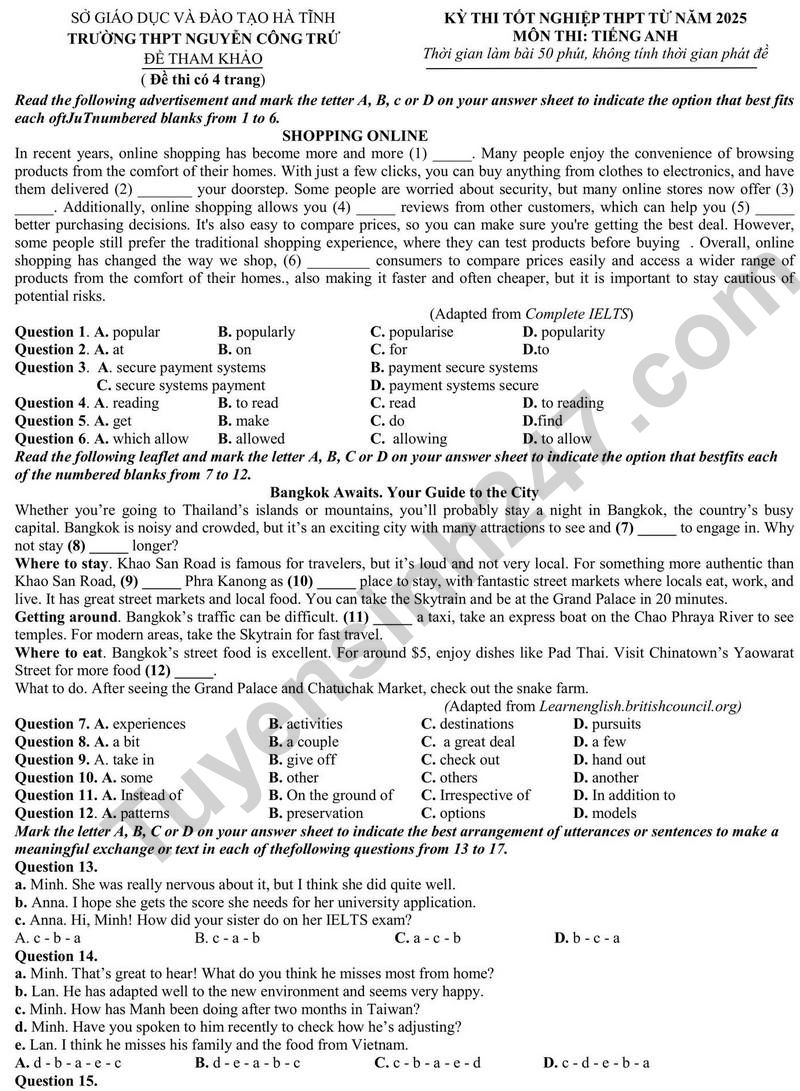
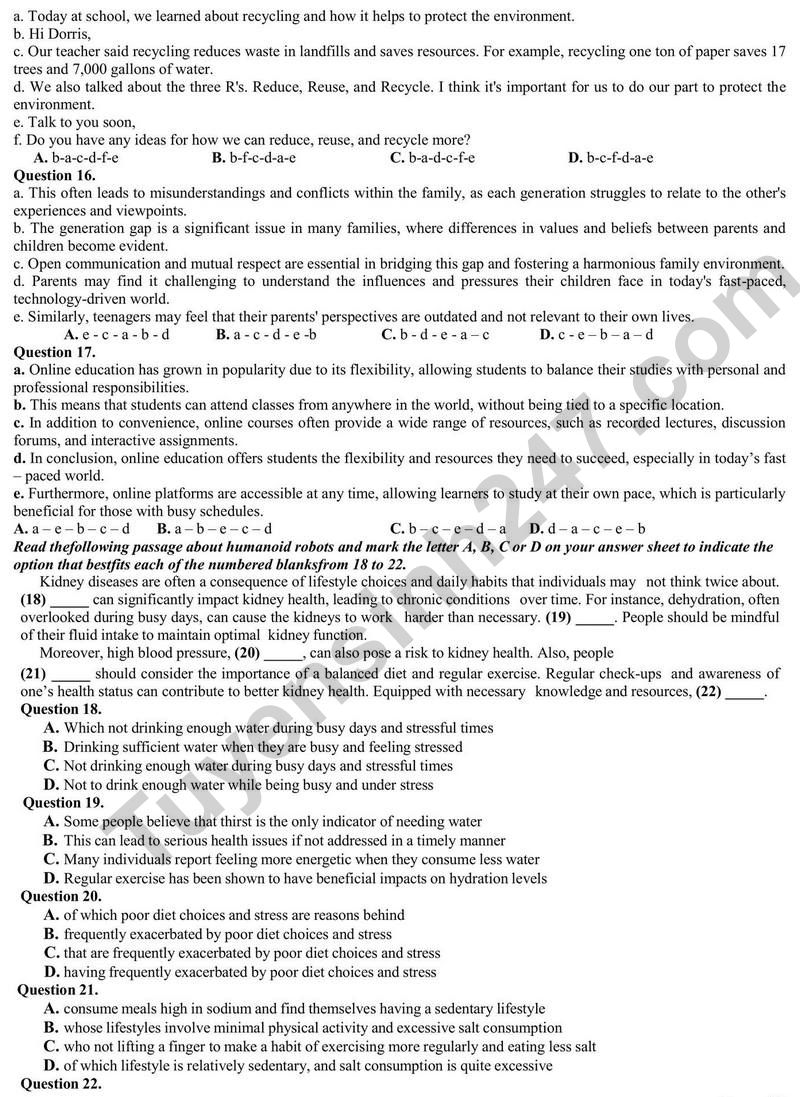
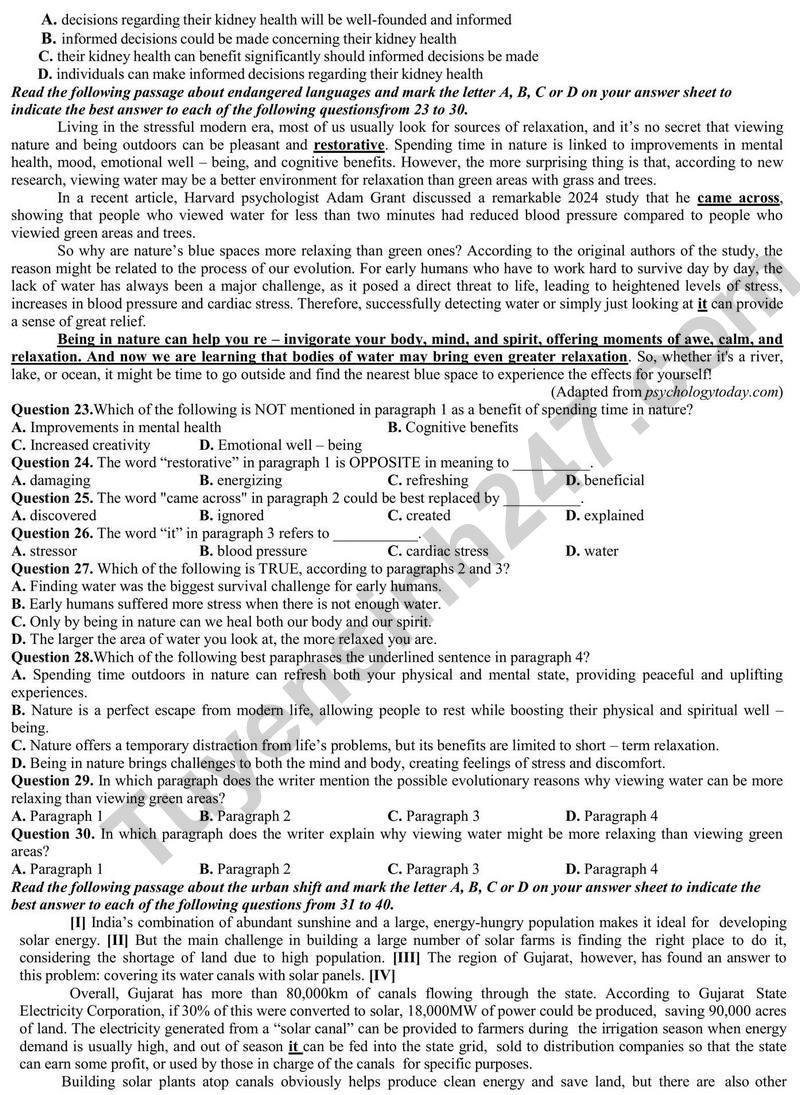
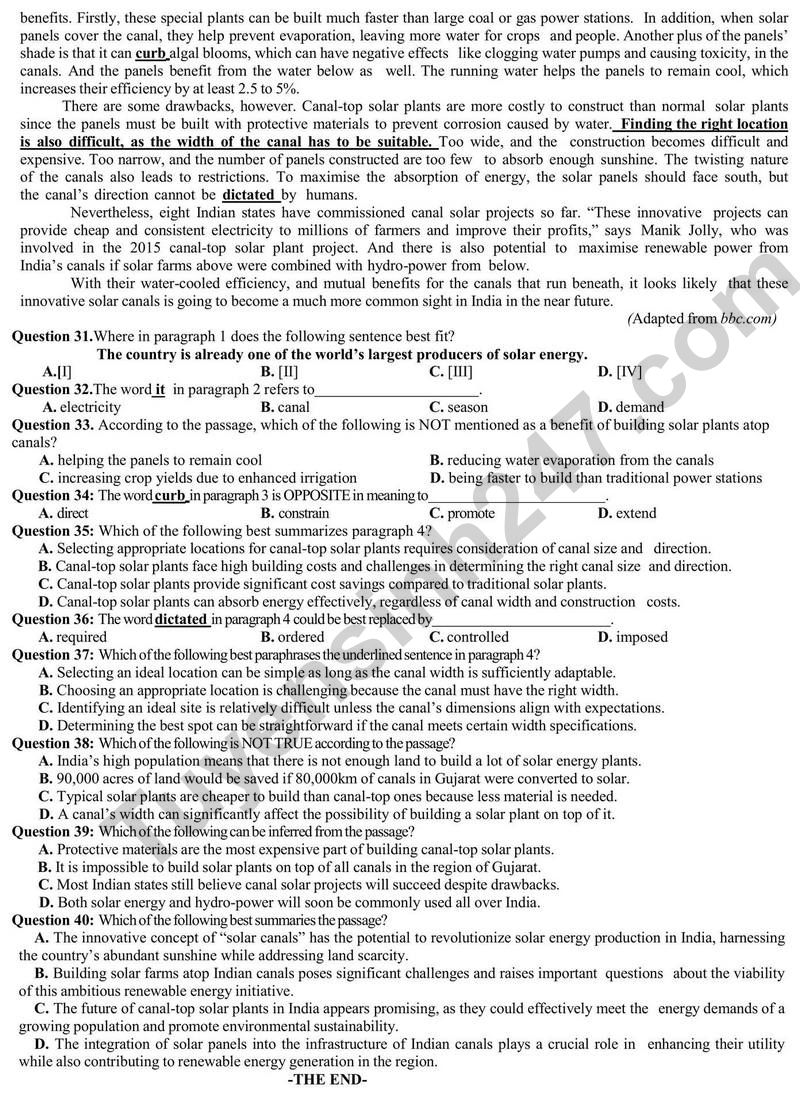
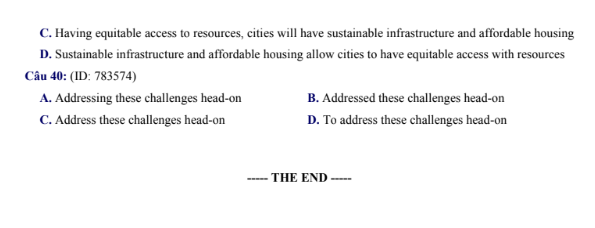
Read the following advertisement and mark the letter A, B, C, or D on your answer sheet to indicate the option that best fits each OfThe numbered blanks from 1 to 6.
SHOPPING ONLINE
In recent years, online shopping has become more and more (1) ______. Many people enjoy the convenience of browsing products from the comfort of their homes. With just a few clicks, you can buy anything from clothes to electronics, and have them delivered (2) ______ your doorstep. Some people are worried about security, but many online stores now offer (3) ______. Additionally, online shopping allows you (4) ______ reviews from other customers, which can help you (5) ______ better purchasing decisions. It’s also easy to compare prices, so you can make sure you’re getting the best deal. However, some people still prefer the traditional shopping experience, where they can test products before buying. Overall, online shopping has changed the way we shop, (6) ______ consumers to compare prices easily and access a wider range of products from the comfort of their homes., also making it faster and often cheaper, but it is important to stay cautious of potential risks.
(Adapted from Complete IELTS)
Question 1:
A. popular
B. popularly
C. popularise
D. popularity
Question 2:
A. at
B. on
C. for
D. to
Question 3:
A. Secure payment systems
B. Secure systems payment
C. payment secure systems
D. payment systems secure
Question 4:
A. reading
B. read
C. to read
D. to reading
Question 5:
A. get
B. make
C. do
D. find
Question 6:
A. which allow
B. allowed
C. allowing
D. to allow
Read the following leaflet and mark the letter A, B, C, or D on your answer sheet to indicate the option that bestfits each of the numbered blanks from 7 to 12.
Bangkok Awaits, Your Guide to the City
Whether you’re going to Thailand’s islands or mountains, you’ll probably stay a night in Bangkok, the country’s busy capital. Bangkok is noisy and crowded, but it’s an exciting city with many attractions to see and (7) ______ to engage in. Why not stay (8) ______ longer?
Where to stay. Khao San Road is famous for travelers, but it’s loud and not very local. For something more authentic than Khao San Road, (9) ______ Phra Kanong as (10) ______ place to stay, with fantastic street markets where locals eat, work, and live. It has great street markets and local food. You can take the Skytrain and be at the Grand Palace in 20 minutes.
Getting around. Bangkok’s traffic can be difficult. (11) ______ a taxi, take an express boat on the Chao Phraya River to see temples. For modern areas, take the Skytrain for fast travel.
Where to eat. Bangkok’s street food is excellent. For around $5, enjoy dishes like Pad Thai. Visit Chinatown’s Yaowarat Street for more food (12) ______.
What to do. After seeing the Grand Palace and Chatuchak Market, check out the snake farm.
(Adapted from learnenglish.britishcouncil.org)
Question 7:
A. experiences
B. activities
C. destinations
D. pursuits
Question 8:
A. a bit
B. a couple
C. a great deal
D. a few
Question 9:
A. take in
B. give off
C. check out
D. hand out
Question 10:
A. some
B. other
C. others
D. another
Question 11:
A. Instead of
B. On the ground of
C. Irrespective of
D. In addition to
Question 12:
A. patterns
B. preservation
C. options
D. models
Mark the letter A, B, C or D on your answer sheet to indicate the best arrangement of utterances or sentences to make a meaningful exchange or text in each of the following questions from 13 to 17.
Question 13:
a. Minh, She was really nervous about it, but I think she did quite well.
b. Anna, I hope she gets the score she needs for her university application.
c. Anna. Hi, Minh! How did your sister do on her IELTS exam?
A. c-b-a
B. c-a-b
C. a-c-b
D. b-c-a
Question 14:
a. Lan, He has adapted well to the new environment and seems very happy.
b. Minh. How has Manh been doing after two months in Taiwan?
c. Minh. Have you spoken to him recently to check how he’s adjusting?
d. Lan, I think he misses his family and the food from Vietnam.
A. b-c-a-d
B. b-a-c-d
C. c-b-a-d
D. b-d-c-a
Question 15:
a. Today at school, we learned about recycling and how it helps to protect the environment.
b. Hi Doris,
c. Our teacher said recycling reduces waste in landfills and saves resources. For example, recycling one ton of paper saves 17 trees and 7,000 gallons of water.
d. We also talked about the three R’s: Reduce, Reuse, and Recycle. I think it’s important for us to do our part to protect the environment.
e. Talk to you soon.
f. Do you have any ideas for how we can reduce, reuse, and recycle more?
A. b-a-c-d-f-e
B. b-f-c-d-a-e
C. b-a-d-c-f-e
D. b-c-f-d-a-e
Question 16:
a. This often leads to misunderstandings and conflicts within the family, as each generation struggles to relate to the other’s experiences and viewpoints.
b. The generation gap is a significant issue in many families, where differences in values and beliefs between parents and children become evident.
c. Open communication and mutual respect are essential in bridging this gap and fostering a harmonious family environment.
d. Parents may find it challenging to understand the influences and pressures their children face in today’s fast-paced, technology-driven world.
e. Similarly, teenagers may feel that their parents’ perspectives are outdated and not relevant to their own lives.
A. b-a-d-e-c
B. a-c-d-e-b
C. b-d-e-a-c
D. c-e-b-a-d
Question 17:
a. Online education has grown in popularity due to its flexibility, allowing students to balance their studies with personal and professional responsibilities.
b. This means that students can attend classes from anywhere in the world, without being tied to a specific location.
c. In addition to convenience, online courses often provide a wide range of resources, such as recorded lectures, discussion forums, and interactive assignments.
d. In conclusion, online education offers students the flexibility and resources they need to succeed, especially in today’s fast-paced world.
e. Furthermore, online platforms are accessible at any time, allowing learners to study at their own pace, which is particularly beneficial for those with busy schedules.
A. a-b-e-c-d
B. a-c-b-e-d
C. a-b-c-e-d
D. a-d-c-e-b
Read the following passage about humanoid robots and mark the letter A, B, C or D on your answer sheet to indicate the option that bestfits each of the numbered blanks from 18 to 22.
Kidney diseases are often a consequence of lifestyle choices and daily habits that individuals may not think twice about. (18) ______ can significantly impact kidney health, leading to chronic conditions over time. For instance, dehydration, often overlooked during busy days, can cause the kidneys to work harder than necessary. (19) ______ People should be mindful of their fluid intake to maintain optimal kidney function. Moreover, high blood pressure, (20) ______, can also pose a risk to kidney health. Also, people (21) ______ should consider the importance of a balanced diet and regular exercise. Regular check-ups and awareness of one’s health status can contribute to better kidney health. Equipped with necessary knowledge and resources, (22) ______.
Question 18:
A. Which not drinking enough water during busy days and stressful times
B. Drinking sufficient water when they are busy and feeling stressed
C. Not drinking enough water during busy days and stressful times
D. Not to drink enough water while being busy and under stress
Question 19:
A. some people believe that thirst is the only indicator of needing water
B. This can lead to serious health issues if not addressed in a timely manner
C. Many individuals report feeling more energetic when they consume less water
D. Regular exercise has been shown to have beneficial impacts on hydration levels
Question 20:
A. of which poor diet choices and stress are reasons behind
B. that frequently exacerbated by poor diet choices and stress
C. which are frequently exacerbated by poor diet choices and stress
D. frequently exacerbated by poor diet choices and stress
Question 21:
A. consume meals high in sodium and find themselves having a sedentary lifestyle
B. whose lifestyles involve minimal physical activity and excessive salt consumption
C. who not lifting a finger to make a habit of exercising more regularly and eating less salt
D. of which lifestyle is relatively sedentary, and salt consumption is quite excessive
Question 22:
A. decisions regarding their kidney health will be well-founded and informed
B. informed decisions could be made concerning their kidney health
C. their kidney health can benefit significantly should informed decisions be made
D. individuals can make informed decisions regarding their kidney health
Read the following passage about endangered languages and mark the letter A, B, C or D on your answer sheet to indicate the best answer to each of the questions from 23 to 30.
Living in the stressful modern era, most of us usually look for sources of relaxation, and it’s no secret that viewing nature and being outdoors can be pleasant and restorative. Spending time in nature is linked to improvements in mental health, mood, emotional well-being – and cognitive benefits. However, the more surprising thing is that, according to new research, viewing water may be a better environment for relaxation than green areas with grass and trees.
In a recent article, Harvard psychologist Adam Grant discussed a remarkable 2024 study that he came across, showing that people who viewed water for less than two minutes had reduced blood pressure compared to people who viewed green areas and trees.
So why are nature’s blue spaces more relaxing than green ones? According to the original authors of the study, the reason might be related to the process of our evolution. For early humans who have to work hard to survive day by day, the lack of water has always been a major challenge, as it posed a direct threat to life, leading to heightened levels of stress, increases in blood pressure and cardiac stress. Therefore, successfully detecting water or simply just looking at it can provide a sense of great relief.
Being in nature can help you re-invigorate your body, mind, and spirit, offering moments of awe, calm, and relaxation. And now we are learning that bodies of water may bring even greater relaxation. So, whether it’s a river, lake, or ocean, it might be time to go outside and find the nearest blue space to experience the effects for yourself!
(Adapted from psychologytoday.com)
Question 23: Which of the following is NOT mentioned in paragraph 1 as a benefit of spending time in nature?
A. Improvements in mental health
B. Cognitive benefits
C. Increased creativity
D. Emotional well-being
Question 24: The word “restorative” in paragraph 1 is OPPOSITE in meaning to ______.
A. damaging
B. energizing
C. refreshing
D. beneficial
Question 25: The word “came across” in paragraph 2 could be best replaced by ______.
A. discovered
B. ignored
C. created
D. explained
Question 26: The word “it” in paragraph 3 refers to ______.
A. stressor
B. blood pressure
C. cardiac stress
D. water
Question 27: Which of the following is TRUE according to paragraphs 2 and 3?
A. Finding water was the biggest survival challenge for early humans.
B. Early humans suffered more stress when there is not enough water.
C. Only by being in nature can we heal both our body and our spirit.
D. The larger the area of water we look at, the more relaxed you are.
Question 28: Which of the following best paraphrases the underlined sentence in paragraph 4?
(The underlined sentence is “And now we are learning that bodies of water may bring even greater relaxation.” at the end of paragraph 3, though the question states paragraph 4)
A. Spending time outdoors can refresh both your physical and mental state, providing peaceful and uplifting experiences.
B. Nature is a perfect escape from modern life, allowing people to rest while boosting their spiritual and physical well-being.
C. Nature offers a temporary distraction from life’s problems, but its benefits are limited to short-term relaxation.
D. Being in nature brings challenges to both the mind and body, creating feelings of stress and discomfort.
Question 29: In which paragraph does the writer mention the possible evolutionary reasons why viewing water can be more relaxing than viewing green areas?
A. Paragraph 1
B. Paragraph 2
C. Paragraph 3
D. Paragraph 4
Question 30: In which paragraph does the writer explain why viewing water might be more relaxing than viewing green areas?
A. Paragraph 1
B. Paragraph 2
C. Paragraph 3
D. Paragraph 4
Read the following passage about the urban shift and mark the letter A, B, C or D on your answer sheet to indicate the best answer to each of the questions from 31 to 40.
[I] India’s combination of abundant sunshine and a large, energy-hungry population makes it ideal for developing solar energy. [II] But the main challenge in building a large number of solar farms is finding the right place to do it, considering the shortage of land due to high population. [III] The region of Gujarat, however, has found an answer to this problem: covering its water canals with solar panels. [IV]
Overall, Gujarat has more than 80,000km of canals flowing through the state. According to Gujarat State Electricity Corporation, if 30% of this were converted to solar, 18,000MW of power could be produced, saving 90,000 acres of land. The electricity generated from a ‘solar canal’ can be provided to farmers during the irrigation season when energy demand is usually high, and out of season it can be fed into the state grid.
Benefits. Firstly, these special plants can be built much faster than large coal or gas power stations. In addition, when solar panels cover the canal, they help prevent evaporation, leaving more water for crops and people. Another plus of the panels’ shade is that it can curb algal blooms, which can have negative effects like clogging water pumps and causing toxicity, in the canals. And the panels benefit from the water below as well. The running water helps the panels to remain cool, which increases their efficiency by at least 2% to 5%.
There are some drawbacks, however. Canal-top solar plants are more costly to construct than normal solar plants since the panels must be built with protective materials to prevent corrosion caused by water. Finding the right location is also difficult, as the width of the canal has to be suitable. Too wide, and the construction becomes difficult and expensive. Too narrow, and the number of panels constructed are too few to absorb enough sunshine. The twisting nature of the canals also leads to restrictions. To maximise the absorption of energy, the solar panels should face south, but the canal’s direction cannot be dictated by humans.
Nevertheless, eight Indian states have commissioned canal solar projects so far. “These innovative projects can provide cheap and consistent electricity to millions of farmers and improve their profits,” says Manik Jolly, who was involved in the 2015 canal-top solar plant project. And there is also potential to maximise renewable power from India’s canals if solar farms above were combined with hydro-power from below.
With their water-cooled efficiency, and mutual benefits for the canals that run beneath, it looks likely that these innovative solar canals is going to become a much more common sight in India in the near future.
(Adapted from bbc.com)
Question 31: Where in paragraph 1 does the following sentence best fit?
“The country is already one of the world’s largest producers of solar energy.”
A. [I]
B. [II]
C. [III]
D. [IV]
Question 32: The word “it” in paragraph 2 refers to ______.
A. electricity
B. canal
C. season
D. land
Question 33: According to the passage, which of the following is NOT mentioned as a benefit of building solar plants atop canals?
A. helping the panels to remain cool
B. reducing water evaporation from the canals
C. increasing crop yields due to enhanced irrigation
D. being faster to build than traditional power stations
Question 34: The word “curb” in paragraph 3 is OPPOSITE in meaning to______.
A. direct
B. constrain
C. promote
D. extend
Question 35: Which of the following best summarizes paragraph 4?
A. Selecting appropriate locations for canal-top solar plants requires consideration of canal size and direction.
B. Canal-top solar plants face high building costs and challenges in determining the right canal size and direction.
C. Canal-top solar plants provide significant cost savings compared to traditional solar plants.
D. Canal-top solar plants can absorb energy effectively, regardless of canal width and construction costs.
Question 36: The word “dictated” in paragraph 4 could be best replaced by______.
A. required
B. ordered
C. controlled
D. imposed
Question 37: Which of the following best paraphrases the underlined sentence in paragraph 4?
(Underlined sentence: “Finding the right location is also difficult, as the width of the canal has to be suitable.”)
A. Selecting an ideal location can be simple as long as the canal width is sufficiently adaptable.
B. Choosing an appropriate location is challenging because the canal must have the right width.
C. Identifying an ideal site is relatively difficult unless the canal’s dimensions align with expectations.
D. Determining the best spot can be straightforward if the canal meets certain width specifications.
Question 38: Which of the following is NOT TRUE according to the passage?
A. India’s high population means that there is not enough land to build a lot of solar energy plants.
B. 90,000 acres of land would be saved if 80,000km of canals in Gujarat were converted to solar.
C. Typical solar plants are cheaper to build than canal-top ones because less material is needed.
D. Canal’s width can significantly affect the possibility of building a solar plant on top of it.
Question 39: Which of the following can be inferred from the passage?
A. Protective materials are the most expensive part of building canal-top solar plants.
B. It is impossible to build solar panels on top of all canals in the region of Gujarat.
C. Most Indian states already believe canal solar projects will succeed despite drawbacks.
D. Both solar energy and hydro-power will soon be commonly used all over India.
Question 40: Which of the following best summarizes the passage?
A. The innovative concept of “solar canals” has the potential to revolutionize solar energy production in India, harnessing the country’s abundant sunshine while addressing land scarcity.
B. Building solar farms atop Indian canals raises significant challenges and raises important questions about the viability of this ambitious renewable energy initiative.
C. The future of canal-top solar plants in India appears promising, as they could effectively meet the energy demands of a growing population and promote environmental sustainability.
D. The integration of solar panels into the infrastructure of Indian canals plays a crucial role in enhancing their utility while also contributing to renewable energy generation in the region.
Mục đích tổ chức kỳ thi Đại học năm 2025 là gì?
Căn cứ theo quy chế hiện hành của Bộ Giáo dục và Đào tạo và các văn bản hướng dẫn tổ chức kỳ thi Đại học năm 2025, mục đích của kỳ thi là:
– Đánh giá kết quả học tập của học sinh sau 12 năm học theo yêu cầu của chương trình giáo dục phổ thông.
– Lấy kết quả thi để xét công nhận tốt nghiệp trung học phổ thông và làm căn cứ tuyển sinh đại học, cao đẳng.
– Góp phần đánh giá chất lượng giáo dục của địa phương và cả nước, làm cơ sở điều chỉnh nội dung, phương pháp dạy học trong nhà trường.
Thí sinh thi Đại học năm 2025 có bắt buộc thi môn Tiếng Anh không?
Theo quy định hiện hành của Bộ Giáo dục và Đào tạo và hướng dẫn tổ chức kỳ thi tốt nghiệp Đại học năm 2025, thí sinh dự thi phải thực hiện như sau:
– Thi 3 môn bắt buộc: Toán, Ngữ văn và Ngoại ngữ.
– Ngoài ra, thí sinh phải chọn một trong hai bài thi tổ hợp: Khoa học Tự nhiên (gồm các môn Vật lí, Hóa học, Sinh học) hoặc Khoa học Xã hội (gồm các môn Lịch sử, Địa lí, Giáo dục công dân – dành cho học sinh học chương trình giáo dục phổ thông).
Trong số các môn thi, Tiếng Anh là một trong ba môn thuộc bài thi Ngoại ngữ bắt buộc, thí sinh phải thi môn Tiếng Anh như một môn bắt buộc, không phụ thuộc vào lựa chọn bài thi tổ hợp hay mục đích xét tuyển đại học.
Như vậy, kỳ thi Đại học năm 2025 bắt buộc thí sinh phải thi môn Tiếng Anh.

